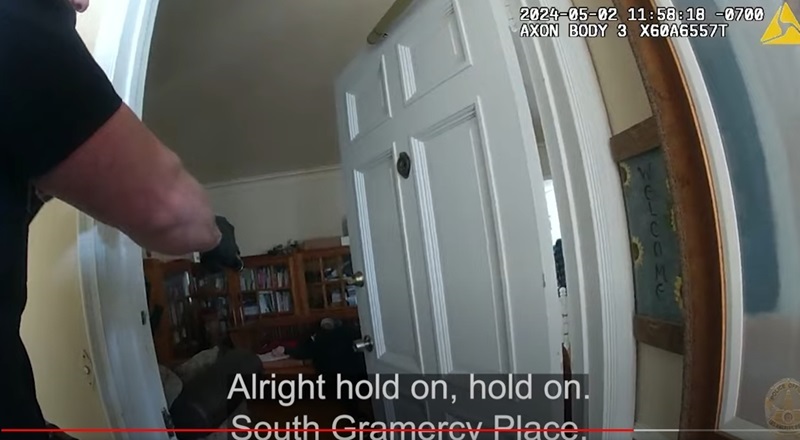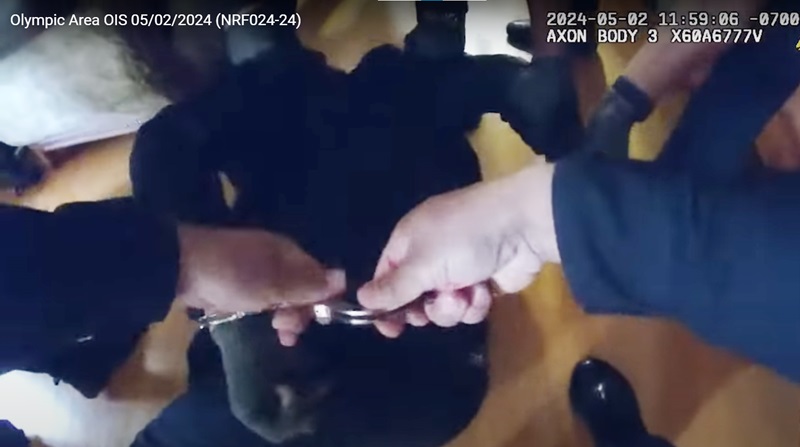Police body-camera footage of Yong Yang, 40, who was shot dead by a police officer on May 2, was released on May 16, two weeks after the incident. The footage, released by the Los Angeles Police Department, shows a terrified Yang after police confronted him.
According to the video, the police shooting occurred at 11:57 a.m. on May 2. In the video, six officers enter the hallway of the house after being handed a key by Yang’s family. The officers used the key to force open the door without a search warrant. At that moment, in the living room, Yang, holding a kitchen knife in his left hand, turned to face the officers and backed away.

The officer in the lead entered the house, saw the knife in Yang’s hand, and quickly stepped back, drawing his gun. He shouted “Drop it” three times before opening fire. This happened just eight seconds after he opened the door.
The officers’ response to the incident was highly improvised. If they felt threatened, they could have closed the door again. One of the officers following them was also carrying a non-lethal “bean bag” gun, as shown on the body cam. Nevertheless, the officers fired indiscriminately at a terrified Yang.
The video shows Yang falling onto a couch after being shot. Yang had already stopped moving. His eyes were open and his body was limp. The police handcuffed Yang, who was already unconscious. He didn’t respond to any of their questions. He was not in a state of consciousness to fight back against the police. Nevertheless, the officers continued to emphasize that he should not move and not put his hands in his pockets.
At this point, the officers apparently still believed Yang was alive. They placed Yang on his side, handcuffed him, and removed his top. They began to examine him for gunshot wounds. The fully undressed upper torso showed clear gunshot wounds: two shots to the chest and one to the abdomen.
From this point on, the officers seemed to recognize the seriousness of the situation. This is a very unprofessional police response to an emergency situation. They shook him and asked him urgently, “Can you hear us?” and “Breathe!” but he didn’t respond. They appeared to be performing cardiac massage, but no other emergency measures were taken.
Despite the department’s release of the body cameras, some problems would undermine its justification for the police shooting. The body cameras show that Yang refused to open the door at the time, but the officers forced it open and entered. That action caused an expected confrontation.
Earlier, a supervisor on the scene said that the only way to force him to come out was to arrest him for “trespassing.” “We can’t force him to come out to get medical treatment,” he said. This statement implies that police have no protocols for dealing with mentally ill people.
Also, at the time of the shooting, the officer with the non-lethal beanbag was directly behind the officer in the lead. But he didn’t even try to use non-lethal weapons to calm down the mentally ill man.

The release of the bodycam footage highlights the excessive use of force by law enforcement and the gaping holes in their response policies. Police firearms regulations need to be radically reformed. For starters, not all instances of police use of force are justified under the law.
In March 2022, in Northern California, Contra Costa County Sheriff’s Department deputy Andrew Hall was sentenced to six years in prison for shooting and killing a mentally ill man (Laudemer Arboleda). The jury found Hall guilty of one count of “assault with a firearm” against him. In the final sentencing, Contra Costa County Superior Court Judge Terri Mockler called Hall’s actions “extremely poor choices” and said, “The victim may have broken the law, but that doesn’t give [the officer] a license to kill him.”
This case is similar to Yang’s in that the victim was mentally ill, the police released the body cameras claiming to have been threatened by the victim first, and the offending officer had a history of two prior “officer-involved shootings.”
The first incident occurred in 2018 during a car chase between police and a mentally ill victim. Records show that the officers chased the victim’s vehicle for about nine minutes, traveling at a low speed of about 6 mph. At that point, Deputy Hall blocked the road with his Sheriff’s vehicle in an attempt to stop the victim’s vehicle, and when he refused to stop, fired nine shots into the driver’s seat, killing him.
The defense released the body-cam footage and argued that “the suspect’s vehicle was pointed at Deputy Hall and his fellow deputies, so he was in a threatening situation,” and that “as an officer, he was concerned for his safety and had to make split-second decisions,” but this did not convince the jury.
Police use of firearms is a citizen-granted right. As such, there are strict limits on their use of firearms to prevent innocent people from being killed in the name of law enforcement. A petition has been started on the online petition site change.org to limit police use of firearms against mentally ill people.
By Mooyoung Lee lee.mooyoung@koreadaily.com

![Clovine accelerates global expansion in collaboration platform market Website of Clovine, a cloud-based project management provider [Screenshot]](https://www.koreadailyus.com/wp-content/uploads/2025/04/0403-clovine-100x70.jpg)

![Hangar images indicate North Korean advances in military drone domain Satellite photos taken on March 28, included in Beyond Parallel's report on North Korea, shows what appears to be seven new drone hangars at the Banghyon Air Base. [SCREEN CATPURE]](https://www.koreadailyus.com/wp-content/uploads/2025/04/0402-Hangar-100x70.jpg)
